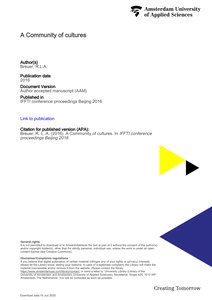This paper discusses the concepts and social dynamics of fashion imitation and custom imitation as put forth by French sociologist Gabriel Tarde (1843-1904). Specifically his 1903 book The Laws of Imitation will be introduced and used to argue that, and examine how, fashion has, since the turn of the century, increasingly become a global custom rather than the exemplary innovative force Tarde associated with fashion. The second part of the paper therefore suggests turning to custom and tradition may be fruitful to revitalise the current state of fashion and can cause new fashions to come into being. The traditional technique used by the people of the Dutch village of Staphorst to decorate the fabrics for their traditional costumes - Staphorster stippling - which is nominated to be inscribed on UNESCO’s list of intangible cultural heritage, is presented as a case study in which it is shown how cultural traditions may unilaterally contribute to ethical, ecological and innovative fashion design. It is furthermore argued that the reciprocal effect of the dynamics between custom and fashion accounts for the preservation of traditional skills and techniques. The text concludes by examining the chances and opportunities as well as the pitfalls one may associate with the proposed dynamic interaction between fashion and tradition.
DOCUMENT

This article argues for an updated theoretical framework in fashion studies. It proposes that perspectives emphasizing the social role and the technological nature of dress should be considered complementary, and that their joint application can contribute to new understandings of fashion history. Employing ethnographic methods, this stance is explored through a comparative analysis of the sartorial practices of two groups of women living or working in Amsterdam during the 1950s and the 2010s. A theoretical framework integrating theories of identity (mainly based on the writings of Georg Simmel and Gabriel Tarde) and the philosophy of technology (in this case the device paradigm of Albert Borgmann) allows us to uncover a paradoxical history of fashion in which clothing shifts roles, transforming from “things of imitation” into “devices of differentiation.”
DOCUMENT
